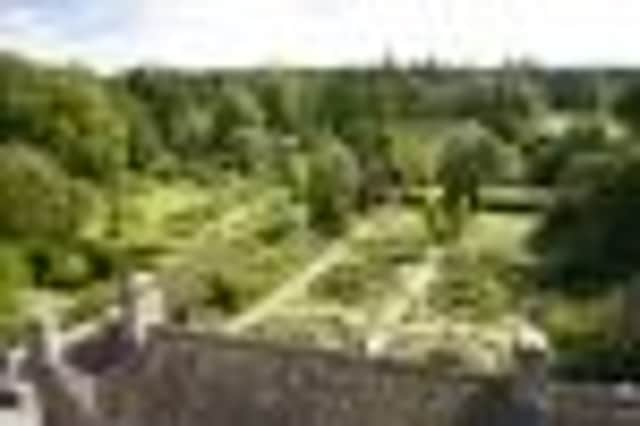Gardens: Cawdor Castle, Nairn


Here, as almost everywhere else, the rain battered the garden this summer, and the snow and freezing temperatures of recent winters made a mockery of Morayshire’s reputed mild climate and damaged many precious plants.
However, walking around these historic gardens there is no sign of a behind-the-scenes struggle.
Advertisement
Hide AdAdvertisement
Hide AdNothing about the immaculate Saltire-shaped, box-edged parterre suggests winter damage and there are no obvious gaps where the trees, so beloved by generations of Cawdors, might have failed.


The presence of the castle, parts of which date from the medieval era and which forms a dramatic focal point at the heart of the grounds, suggests this garden can and will survive anything nature can throw at it, a point reinforced by a group of 80-year-old Acer palmatum on the castle lawn.
And yet, without the two knowledgeable pairs of hands that are on the tiller, things might be very different.
When Lady Cawdor married Hugh, 25th Thane of Cawdor, 33 years ago, she found an ancient castle surrounded by historic garden that had been tended by generations of the Campbell family. “Oval rose beds underplanted with lavender date from an 18th century design introduced by the then Lord Cawdor, who saw something similar while travelling in France.”
While maintaining the same basic structure, different individuals adapted the planting to suit their particular circumstance and fashions.
For Lady Cawdor the sense of being part of a long line of gardeners dating back centuries was from the outset a humbling and poignant experience.
“When you marry into an ancient family you have to start thinking in a historical context right away,” she says firmly. “Cawdor has been part of a long chain of people whose job it is to care for them; I am just part of that chain. It would be a mistake to come in and change things and modernise them.”
At the beginning, she says, she knew very little about gardening and was content to sit back and watch her husband, a keen and knowledgeable gardener.
Advertisement
Hide AdAdvertisement
Hide AdAfter developing an interest in garden conservation, stimulated by records found at Cawdor relating to items such as lists of garden seeds imported from France in the 16th century, she began practising her skills on a space south of the castle. “I was very keen but I knew nothing about gardening, but I did know about symbolism,” she says.
“It was quite daunting at first as it was quite a large space.”
After much note taking, detailed research and garden visiting, a plan evolved for the creation of a series of gardens based on different themes. Once this plan was in place the garden began to take shape quite rapidly.
The first was Paradise, “difficult to access but peaceful when you get there”. The focal point of this circle is a copper fountain backed with a border including Rosa Nevada, scented philadelphus, dicentra and Helleborus argutifolius, all of which are in “whiter shades of pale”.
Drawing on the importance of structure, especially in winter, is important. Another space symbolises Earth and is laid out in box hedging from the design on an old sampler of Scottish knots found in the house.
Here are medicinal plants that might be found in a Still Room, such as iris, whose roots have healing qualities, and include lavender and a variety of culinary herbs. Between Paradise and Earth is another garden called Purgatory planted with 20 different varieties of thistles.
“It was great fun researching the different varieties and learning about them.” The Garden of Eden features varieties of old Scottish apple trees. All the gardens were laid out with bamboo sticks and string pegged to the ground before any work started.
The use of symbolism to define the garden continues in the long herbaceous border where Lady Cawdor drew on the colour symbolism of Goethe, whose treatise suggest that colour perception is a matter for our minds rather than our eyes. For example: green soothes, while yellow is positive, orange joyful and red considered to be the most intense colour. Hence the striking use of orange and yellow lilies, and hemerocallis and tall red lupins set against a background of green yew hedges.
Advertisement
Hide AdAdvertisement
Hide AdVegetables, notably historic varieties, grown from seeds available from Henry Doubleday Research Institute are another passion: the garden has been organic for 35 years. “We aim for taste rather than quantity.
All vegetables are grown by dynamic principals according to the season.”
Pests are kept under control by appropriate companion planting. The result, in winter, is a variety of root vegetables such as celeriac, swedes, Jerusalem artichokes, parsnips, carrots and leeks.
“I choose plants only if I really like them,” Lady Cawdor adds. “I consider shape or flower, colour of bark for winter, scent and texture of leaves. I tend to stick to traditional plants. I try and avoid things that are fashionable. In this garden you are always aware of the castle. I am not a gardener in the hands and knees sense, but I am an ideas and planning person.”
Cawdor has always attracted wild life, notably red squirrels, but also varieties of different birds and planting bears their needs in mind. The most recent introduction of a bronze birdfeeder by artist Elinoa Morris has boosted numbers, while adding interest.
Since Lord Cawdor’s death in 1993, Lady Cawdor has, she stresses, relied heavily on the skill and hard work of Derek Hosie who interprets her ideas and translates them into reality. Their combined, determined approach and attention to detail has maintained continuity at Cawdor while ensuring the gardens maintain their rightful place at the head of Scotland’s ancient gardens.
Cawdor Castle, Nairn, IV12 5KD.
The gardens are open daily from May 2013 between 10am and 5:30pm
(01667 404 4011, www.cawdorcastle.com)